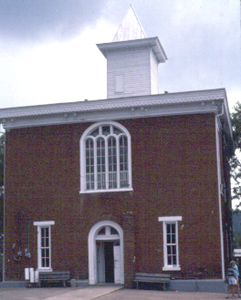
Clay County
The Tennessee General Assembly created Clay County on June 16, 1870, from the isolated northern sections of Overton and Jackson Counties. Citizens of the new county believed they would have a better opportunity to participate in self-government in their own county rather than as part of the larger county governments with which they had previously been connected by only a few trails and no roads. The first session of the county court met in Mary Roberts's store in the Butler's Landing community. Celina was chosen as the county seat by a narrow margin. Local craftsman D. L. Dow built the Clay County Courthouse (1872-73), which is listed on the National Register of Historic Places.
In 1870 Clay County was a dense forest of virgin timber. Freight and manufactured goods came into the county by river or the Great Road, part of a stage road that linked Georgia and Alabama to Cookeville. Bordering on Kentucky, the area was deeply divided during the Civil War, and hard feelings between the ridge dwellers and the river people inhibited economic growth and political development. Some families moved west, but those who remained soon became engaged in harvesting the timber. By 1880 the timber industry in Clay County was big business, and in 1890 the timber harvest produced millions of feet of cut boards at more than twenty sawmills. In addition, lumbermen cut, rafted, and floated logs to Nashville during the spring high water. During the peak of timbering, the county's assessed valuation reached nearly $11 million, and the population topped nine thousand. By 1930 the timber was gone, the land was washed away, and river traffic had been replaced by the automobile. The loss of the timber industry and the Great Depression struck the Upper Cumberland hard.
The family of Cordell Hull, U.S. secretary of state under President Franklin D. Roosevelt and Nobel Prize recipient, played a large role in the county's development. Hull's first law office was located just off the square in Celina. Hull's father, Billy Hull, constructed several Celina buildings that are still in use today. Bob Riley, one of the most widely known rivermen, lives on in his tales and stories of the rafting days, and Riley's log cabin still stands on the banks of the Obey River. Calvin Hamilton of the Free Hill community was another well-known riverman still remembered in Cumberland River stories.
In addition to serving as the county seat, Celina, located at the confluence of the Obey and Cumberland Rivers, became an important stop in the logging and steamboat trade. The Kyle family operated a rafting business that employed about one hundred men. Rafters found Celina, with its two hotels–the New Central Hotel and the Riverside Hotel–a hospitable place to stop on the seven-day journey to Nashville. Steamboats also made regular stops to bring mail and manufactured goods and haul away chickens, lumber, and other farm products. The steamboats continued to meet the transportation needs of Celina and Clay County until the 1920s and 1930s, when highway construction and automobiles ended the trade.
North of Celina is Free Hill, an African American community dating to perhaps as early as 1830. Robert “Bud” Garrett of Free Hill acquired considerable regional renown for making flint marbles used by blacks and whites alike in the popular local game of rolley hole marbles. During the 1940s he purchased a school bus with the proceeds from his marble making and shuttled community residents to jobs in Celina.
The Obey and Cumberland Rivers provided transportation and a link to Nashville and beyond, but they also flooded periodically with devastating results. In 1943 the U.S. Army Corps of Engineers finally achieved a long-sought goal and built the first dam on the Obey, creating the huge Dale Hollow Reservoir. Dale Hollow Dam tamed a wild river and drew tourists and fishermen to the vacation and recreation area but destroyed valuable farmland. The community of Willow Grove disappeared completely under the waters of the reservoir.
In 1950 the garment industry moved into the county. For the next forty years, needlework factories ranked among the largest employers in the county; in 1990, however, the textile plants began moving to other countries. Timber and lumber industries still account for a large segment of the county economy in the form of pallet mills and the log home business. Seasonal tourist jobs also employ a number of people.
Despite modern transportation advances, Clay County still retains some of the isolation common to the nineteenth century. The location of the county along the Kentucky border and the number of rivers that cross the county separate communities and people in important ways. The west end of the county maintains a high school and grade school in the Hermitage Springs community. In the middle section of the county school children attend the high school and grade school in Celina. The east end, now cut off by Dale Hollow Lake, can be reached only by entering Overton County, but residents transport their children to schools in Celina. Nevertheless, each area maintains its own fire halls and a spirit of community citizenship. The county’s population was 7,976 in 2000.



